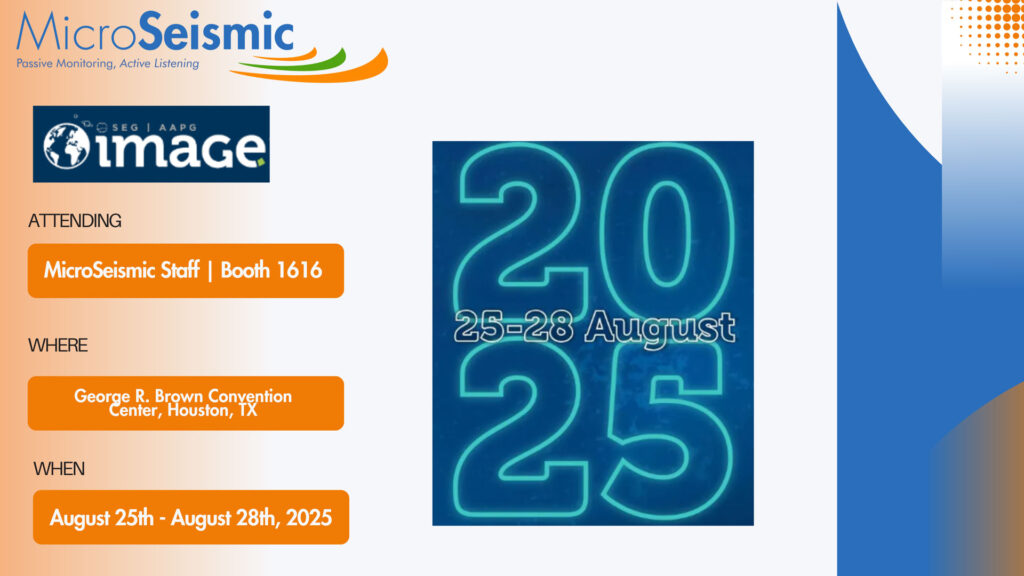
- This event has passed.
URTEC
Jul 23, 2018 - Jul 25, 2018
URTeC Booth Presentation Schedule
July 23-25, 2018
Booth #2509
| MONDAY | 10:00 am - 7:00 pm | Topic | Presenter | ||||||
|---|---|---|---|---|---|---|---|---|
| 10:15 | Real-time Fault Detection and Mitigation | Orlando Teran | ||||||
| 10:30 | Real-time Fracture Modeling and Completions Diagnostics | Mike Thornton | ||||||
| 10:45 | Parent-Child Effect and the Impact on Recovery | Carl Neuhaus | ||||||
| 11:00 | Cube Development in the Permian: Estimating Production and Drainage Volume | Asal Zeynal | ||||||
| 12:00 | Lunch & Learn: The Future of Hydraulic Fracturing: Getting It Right At Every Stage | Peter Duncan | ||||||
| 3:15 | Fracturing Out of Zone and The Impact on Production | Carl Neuhaus | ||||||
| 3:30 | Real-time Fault Detection and Mitigation | Orlando Teran | ||||||
| 5:15 | Real-time Fracture Modeling and Completions Diagnostics | Michael Thornton | ||||||
| 5:30 | Parent-Child Effect and the Impact on Recovery | Carl Neuhaus | ||||||
| 5:45 | Cube Development in the Permian: Estimating Production and Drainage Volume | Asal Zeynal | ||||||
| 6:00 | Fracturing Out of Zone and The Impact on Production | Carl Neuhaus | ||||||
| TUESDAY | 9:00 am - 6:00 pm | Topic | Presenter | ||||||
| 10:15 | Real-time Fault Detection and Mitigation | Orlando Teran | ||||||
| 10:30 | Real-time Fracture Modeling and Completions Diagnostics | Mike Thornton | ||||||
| 10:45 | Parent-Child Effect and the Impact on Recovery | Carl Neuhaus | ||||||
| 3:10 | Cube Development in the Permian: Estimating Production and Drainage Volume | Asal Zeynal | ||||||
| 3:25 | Fracturing Out of Zone and The Impact on Production | Carl Neuhaus | ||||||
| 3:40 | Real-time Fault Detection and Mitigation | Orlando Teran | ||||||
| 5:15 | Real-time Fracture Modeling and Completions Diagnostics | Michael Thornton | ||||||
| 5:30 | Parent-Child Effect and the Impact on Recovery | Carl Neuhaus | ||||||
| 5:45 | Cube Development in the Permian: Estimating Production and Drainage Volume | Asal Zeynal | ||||||
| WEDNESDAY | 9:00 am - 1:00 pm | Topic | Presenter | ||||||
| 10:15 | Real-time Fault Detection and Mitigation | Orlando Teran | ||||||
| 10:30 | Real-time Fracture Modeling and Completions Diagnostics | Michael Thornton | ||||||
| 10:45 | Fracturing Out of Zone and The Impact on Production | Carl Neuhaus | ||||||
| 11:30 | Lunch & Learn: Tank Development in the Midland Basin, Texas: A case study of super-charging a reservoir to optimize production and increase horizontal well densities | Jill Thompson, QEP Resources |
Abstracts
Real-time Fracture Modeling and Completions Diagnostics Presented by Mike Thornton
Real-time microseismic monitoring provides a unique opportunity to measure the dynamic response of the earth to well stimulation. Rapid determination of the microseismic location and failure plane, allows real-time visualization of the effects of treatment and assessment of the induced fracture volume. Real-time fracture models allow rapid estimation of drainage volume while the well is being fraced.
Real-Time fault detection and mitigation Presented by Orlando Teran
Fracturing Out of Zone and The Impact on Production presented by Carl Neuhaus
Hydraulic stimulation of five wells in the Woodford reactivated multiple fault sets that were not visible in 3D seismic. Microseismic-based reservoir simulation highlights the decrease in treatment efficiency and the impact on drainage.
Cube Development in the Permian: Estimating Production and Drainage Volume Presented by Asal Zeynal
Full-field development with high wellbore density in multiple target zones poses challenges regarding interaction between wellbores and decrease in recovery per section. Microseismic-based reservoir simulation is used to understand the complexity of draining such a system and identifies the potential for an additional drilling location.
Parent-Child Effect and the Impact on Recovery Presented by Carl Neuhaus
Pressure depletion of a parent well acts as a sink for the injected fluid on the child well therefore reducing treatment efficiency and potentially overall recovery. Microseismic data collected during the stimulation of both parent and child wells four years apart make this effect visible and quantify it in a reservoir model.
The Future of Hydraulic Fracturing: Getting It Right At Every Stage Presented by Peter Duncan
A forward looking view on the future of unconventional field development, frac’ing and frac monitoring.”
Tank Development in the Midland Basin, Texas: A case study of super-charging a reservoir to optimize production and increase horizontal well densities Presented by Jill Thompson
Tank Development aims to exploit a volume of rock at one time to maximize reservoir potential. The fundamental principle of Tank Development is maximizing well productivity by “super-charging” the reservoir prior to simultaneous initiation of production. The results of a surface microseismic array indicate evidence of breaking more rock when Tank Development is employed and also show an increase in near-wellbore fracture complexity for wells that were stimulated later in the Tank Development sequence. Tank Development has proven essential for maximizing asset value during simultaneous development of multiple horizons with horizontal wells in close proximity to one another.


